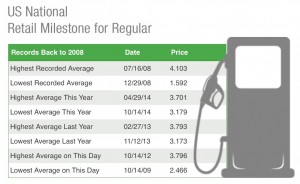If you’ve got to fill up your tank for the daily commute, you might not dread watching the numbers spin on the pump these days, at least not as much as you did earlier in the year when prices nudged $4 a gallon in many parts of the country.
Motorists in Missouri, for example, are now paying an average of just $2.877 a gallon, according to a survey by GasBuddy.com, the lowest figure in the country. But the tracking site found that eight other states have dropped below the $3 mark, with some estimates predicting as many as 30 could dip below that figure in the weeks to come.
The current downturn might last for some time, according to the federal agency tasked with tracking energy trends. Meanwhile, a wire report out of the Mideast indicates that the government of Saudi Arabia is quietly sending out signals that it won’t take steps to boost fuel prices for as much as a year or more.
According to the U.S. Energy Information Administration, the average price of gasoline across the country had dipped to $3.299 on Oct. 6, a weekly decline of nearly six cents. An update due this week is expected to show a further decline – something borne out by the rapid drop in pump prices reported by GasBuddy, the AAA and other tracking services.
Motorists along the Gulf Coast – where much of the petroleum is sourced offshore – have seen some of the biggest drops, and are, on average, paying the lowest regional price, according to the EIA, at $3.109. Drivers in the Midwest are close behind, at an average $3.195.
GasBuddy reports the lowest price, on a statewide level, is Missouri, at $2.877. At the other extreme is Hawaii, at an average $4.128. Ironically, Alaska, with its huge crude oil sources, has an average price of $3.836, and California continues to see the highest prices among the Lower 48 states, at $3.59.
But with few exceptions, prices have been plunging and showing no sign of bouncing back.
Oil traders seem to have written off the sort of news stories that normally send crude oil futures surging upward, such as the ongoing battle with Islamic radicals in Syria and Iraq.
One reason may be the quiet acquiescence of Saudi Arabia, the world’s largest oil producer and normally the driving force behind any moves taken by the global oil cartel OPEC.
According to a report by the Reuters news service, the kingdom “will accept oil prices below $90 per barrel, and perhaps down to $80, for as long as a year or two, according to people who have been briefed on…recent conversations” within OPEC.
The strategy might seem surprising, but Reuters suggests that the Saudi’s are actually taking steps that could ensure higher prices for OPEC in the future by heading off the expansion of oil production outside the cartel. In particular, low oil prices could derail the expansion of drilling in the U.S. and especially further efforts to tap North American shale oil formations.
(Fuel prices plunge in the U.S. For more, Click Here.)
The Saudis “will accept a price decline necessary to sweat whatever supply cuts are needed to balance the market out of the U.S. shale oil sector,” Robert McNally, a White House adviser to former President George W. Bush and president of the Rapidan Group energy consultancy, has advised his clients.
(Click Here for details on Mazda’s rotary revival plans.)
Whatever the reason – and whatever the long-term results – the current decline can only be seen as good news for U.S. motorists who saw prices nudge $4 earlier in the year, with some analysts warning the figure could run sharply higher.
Not everyone is pleased, however. Proponents of increased fuel economy complain that the sudden dip in pump prices has led to resurgence in demand for pickups and other fuel-gulping trucks and crossover vehicles.
(To see more about Ford adding 850 jobs for F-150 production, Click Here.)
The EPA this month noted that U.S. motor vehicle fuel economy hit an all-time record last year, while cautioning that the gains appeared to be slowing. A separate report by the University of Michigan Transportation Research Institute, or UMTRI, indicated the fuel economy of vehicles sold in recent months had dipped sharply as truck sales surged.
Rising demand for fuel could eventually add upward momentum to fuel prices.


“According to a report by the Reuters news service, the kingdom “will accept oil prices below $90 per barrel, and perhaps down to $80, for as long as a year or two, according to people who have been briefed on…recent conversations” within OPEC.
The strategy might seem surprising, but Reuters suggests that the Saudi’s are actually taking steps that could ensure higher prices for OPEC in the future by heading off the expansion of oil production outside the cartel. In particular, low oil prices could derail the expansion of drilling in the U.S. and especially further efforts to tap North American shale oil formations.”
Interesting that the truth was actually told; lower the price to discourage outside drilling then whamo, jump the price up when everyone else’s drills are down
“Nudged $4.00 per gallon”? It was over that in some parts of the North East, especially in metro NYC where we can apparently be counted on to pay through the nose despite no real rise in income and increasing disparity. The gas guzzler taxes are outrageously low for the likes of Italian cars and Germans with enormous 12s. They can easily afford the $4K tacked on to initial cost, and it does nothing to balance the price they should be paying at the pump if those of us with frugal cars must do the same to allow them their luxuries.
Anyone who doesn’t think the oil industry Cabal/Cartel is going to exploit consumers as much as possible is naïve. Controlling the supply makes it a monopoly and that’s what they will continue to maintain.